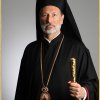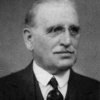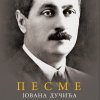On 25 May 2016 the Holy Assembly of Bishops of the Serbian Orthodox Church elected by acclamation Bishop Irinej of Australia and New Zealand to the Throne of Bishops of Eastern America following the election of Bishop Mitrophan of Eastern America to the Throne of Bishops of Canada.
He was born in 1955 in Cleveland, Ohio, USA, to his father Djuro and mother Milica (nee Svilar). His elementary and secondary education was completed in Cleveland, Ohio. After attending the Cleveland Institute of Art from 1973–1975, he attended St. Tikhon’s Orthodox Theological Seminary in South Canaan, Pennsylvania from 1975–1979, where he graduated with a Licentiate in Theology with the academic distinction maxima cum laude. In 1980 he enrolled in St. Vladimir’s Orthodox Theological Seminary in Crestwood, New York and graduated in 1982 with a Master of Divinity degree with Honorable Mention for his master’s thesis Bishop Nicholai Velimirovich: A 1921 Mission to America. Following which, he entertained studies at the Athens Centre in 2000 and 2003 receiving levels I and II certificates in contemporary Greek language.
He spent most of his career in the field of education. He lectured as visiting fellow at Loyola University in Chicago and visiting fellow at the Faculty of Orthodox Theology in Belgrade. For many years he was the co-editor of The Path of Orthodoxy, the official publication of the Serbian Orthodox Church in the USA and Canada.
Metropolitan Christopher of Midwestern America ordained him a deacon on 15 January 1994 at the Holy Resurrection Serbian Orthodox Cathedral in Chicago, Illinois. He was tonsured a monk on 18 January 1995 at the St. Sava Monastery in Libertyville, Illinois, receiving the monastic name Irinej after St. Irenaeus, Bishop of Lyons. Thereafter, he was ordained a hieromonk on January 27, 1995 at the St. Sava Cathedral in Parma, Ohio. He was elevated to the dignity of Archimandrite on June 18, 2006 by Bishop Justin of Timok (presently of Žiča.)
Archimandrite Irinej up until his election as Bishop of Australia and New Zealand was the Consultant to the Holy Synod of Bishops of the Serbian Orthodox Church on International and Interchurch Affairs and Coordinator of the newly created Kosovo and Metohija Office of the Holy Assembly of Bishops of the Serbian Orthodox Church at the Serbian Orthodox Patriarchate in Belgrade. Among his numerous recognitions, especially for his exemplary work in improving ties between the Serbian state and the Serbs of the Diaspora, and for his work in advancing relations between Church and State, in 2005, he was awarded the Order of Vuk Karadzich III Degree by President Svetozar Marović of the State Union of Serbia and Montenegro.
Among his many appointments, it is important to emphasize that Bishop Irinej represents the Serbian Orthodox Church to the World Council of Churches (WCC) Central Committee; is a member of the Jasenovac Committee and the Permanent Missions Board of the Holy Synod of Bishops; the Advisory Council of the Njegoš Endowment for Serbian Studies at Columbia University; and the Editorial Board of the Tesla Memorial Society; and the Communications Committee of the Board of Directors of St. Vladimir’s Seminary, etc.
Previously, Bishop-elect Irinej was the Editor-in-Charge of the Information Service of the Serbian Orthodox Church; Executive Director of the Office of External Affairs of the Serbian Orthodox Church in the USA and Canada, located in Washington, DC; co-chaired the Orthodox Advisory Committee of the National Council of the Churches of Christ in Metropolitan Washington; was a member of National Council of the Churches of Christ Environmental Justice Task Force; and served on the Board of Directors of International Orthodox Christian Charities (IOCC); the Executive Council of The United States Conference of Religions for Peace, the Conference of European Churches, the Serbian Unity Congress, the Mayor’s Advisory Council on Immigrant and Refugee Affairs in Chicago, and the Chicago Human Rights Commission.
On the basis of the decision of the Holy Assembly of Bishops of 26 May 2006, Hieromonk Irinej was elected as Bishop of the Diocese of Australia and New Zealand. He was consecrated on July 15, 2006 in the Holy Archangel Michael Cathedral in Belgrade at the hands of Archbishop Amfilohije of Cetinje, Metropolitan of Montenegro, together with 16 other bishops. He was enthroned on October 21, 2006 in the St. Sava Pro-Cathedral in Elanora Heights, New South Wales by Hrizostom of Bihac-Petrovac, a member of the Holy Synod of Bishops, as Bishop of the Serbian Orthodox Diocese of Australia and New Zealand, with its see in Sydney. The following day, October 22, 2006, His Grace was presented as the Bishop-Administrator for the Diocese for Australia and New Zealand New Gračanica Metropolitanate at the St. Sava Monastery in Wallaroo, New South Wales.
Through his endeavors in drafting a new common constitution for the unification of his two dioceses, the Holy Assembly of Bishops of the Serbian Orthodox Church on May 23, 2011 approved the proposed Constitution of the Metropolitanate of Australia and New Zealand of the Serbian Orthodox Church effecting the unification of the former Diocese of Australia and New Zealand and the Diocese for Australia and New Zealand New Gračanica Metropolitanate. The same were elevated to the dignity of a singular, unified Metropolitanate of Australia and New Zealand. Bishop Irinej holds the distinction of having thus far served the Church in Australia and New Zealand as its longest reigning hierarch. He also served as Chairman of the National Heads of Churches of Australia.
Having taken into consideration his significant diplomatic accomplishments, amongst all else, it was determined by the members of the Holy Assembly of Bishops that he be entrusted with the eminent Diocese of Eastern America with its See in New York City. The rebuilding of the St. Sava Pro-Cathedral in Manhattan, recently destroyed in fire, will be the most formidable historic task awaiting the new Bishop as he assumed the Throne of the Bishops of Eastern America on October 1, 2016 at the hands of Bishop Longin of New Gračanica-Midwestern America in the Cathedral Church of the Holy Trinity in Pittsburgh.





